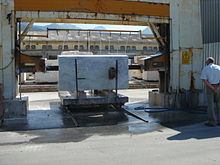Gang saw
A frame saw is a machine used in a sawmill for cutting round wood or natural stone blocks , which is usually driven by a flywheel via a flat belt.
The flywheel uses a connecting rod to move a frame guided on guides up and down, normally with around 270 to 320 strokes, in modern machines with up to 450 strokes per minute. In this gate frame, one or more saw blades are clamped, the distance between them being adjustable.
history
The prerequisite for the construction of frame saws was the ability to convert the rotary motion of a waterwheel, for example, into the thrust motion of the saw. Such mechanisms were available at the end of the 15th century, when the first gang saws were built. Numerous inventions and improvements to these Venetian saws are attributed to the universal genius Leonardo da Vinci . For the history see also: sawmill .
Wood
The log is automatically cut to the width corresponding to the saw blade spacing of the gate.
There are two types of feed: With the permanent feed of modern gate constructions, the oscillating movement of the saw frame ensures that the saw blades are only loaded downwards in their cutting direction and, when the frame moves upwards, they are moved away from the material being cut. The second type of feed is the stop feed , in which the feed is stopped at the lower end point of the saw frame until the frame has reached the upper end point again. This stopping of the feed with each stroke is achieved in older models by pawls (pawl feed) or cam gears, in more modern solutions by electronically controlled servomotors. The swinging movement of the saw frame and the feed stop prevent the upward cut, as the saw blades on gate machines can usually only cut in one direction, downward, due to their tooth shape. In order to use as many teeth as possible, the gate frame is inclined against the cutting direction in all constructions ("overhang"). Modern constructions can adjust their overhang so that it can automatically be optimally adjusted to the feed.
The feed rate of a gate system is usually, depending on the size (stroke and speed), between 2 and max. 14 m / min. There are also a few slightly faster machines. The saw frame used to be the main machine in European sawmills. Meanwhile, the mass of sawn timber is produced on fully automatic profiling lines, the feed rates of which reach up to 170 m / min. For small businesses, however, the gate is still a good alternative.
Mini frame saws are used due to the high cutting accuracy and the extremely thin saws to produce top layers for finished parquet, in the pencil industry, for the production of doors and the like.
Natural stone
Not only wood is grated, but also natural stone : stone blocks that are broken in quarries are cut into slabs and tranches in stone factories with grids .
When it comes to saws, a distinction is made between sand and diamond gates. In the case of sand gates , water is washed into the kerf to cool the saw blades and abrasives , which are called steel sand , to optimize the cutting effect. The diamond gate has so-called "disks", which are covered with diamond and are only cooled with water. The first diamond gates in the late 19th century and later were set with natural diamonds until a synthesis process was invented.



